Vexi-bits are a proud tradition at every NAVA meeting, likewise the 24th International Congress of Vexillology was no exception. Vexi-bits are small presentations centered on flags, they are mostly fun fact trivia items or miscellaneous anecdotes. Vexi-bits can basically be about anything - even flag 'stealing' squirrels.
The Vexi-bits for ICV #24 took place in the open dining hall of Embassy Suites Alexandria, the forlorn Capital of the United States from 1790-1847,
The following vexi-bits are in no particular order: Vexi
Vexi-bit #1: Geoff Parsons - talked a wee bit about the UK flag, and maybe regular Brits will be able to fly the Union Flag without legal
mumbo-jumbo. We learned about what they do at
The Flag Institute. The UK Flag Institute does not yet have a royal charter but one may be coming soon. Nonetheless the UK Flag
Institute continues to act as the leading flag recorder for the United Kingdom.
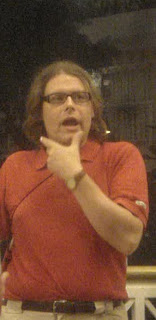 Vexi
Vexi-bit #2:
Marcus Schmoger spoke again about the arms and flag of San
Marino. FYI, San
Marino is a nation inside of Italy. Usually a nation is on the border with another or at least has a coast line. But San
Marino is like Lesotho in South Africa.
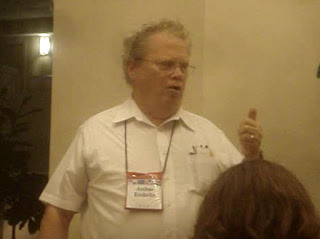 Vexi
Vexi-bit #3: Arthur
Etchells talked about his vast collection of military flags for Czech, Austria and other Northern European
countires.
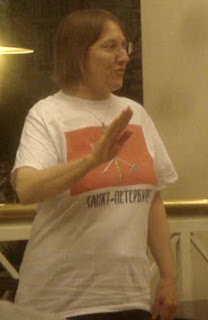 Vexi
Vexi-bit #4:
Annie Platoff - more info on conspiracy theorists about US flag on the moon .
Platoff said the flags for the Apollo missions varied. The Apollo 11 and 12 US flags were 3' x 5' and the flags for Apollo 13
thru 16 flags were 2.5' x 4' and the Apollo 17 flag was 3.5' x 6.6.'
 Vexi
Vexi-bit #5: Phillip
Rault - spoke again about the deaths of flying the Confederate Flag at the Monaco Hotel in Alexandria, Virginia; other Confederate flags; and Irish starry plow flag. He also showed of his own flag for the of Brittany Liberation. It has a Celtic Sun with nine rays. The colours are black, orange and white in horizontal
tri-bar form - black on the bottom, orange in the middle, and white up top. The middle orange bar is thinnest while the upper white bar is thickest.
 Vexi
Vexi-bit #6: Tony Burton - Showed us a comprehensive survey about flags of Australia. And showed us a Islamic War-Prayer Flag: white Arabic
Calligraphy on black and the another that was black Arabic on a white background.
 Vexi
Vexi-bit #7:
Chris Bedwell - Presented the city flag of Phoenix, Arizona. If is composed a North American bald eagle facing the fly with wings spread on top of a rather large yellow sun with many short red rays.
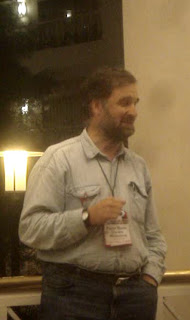 Vexi
Vexi-bit #8:
Peter Hans Van den Muijzenberg - Jacks and flags of Europe.
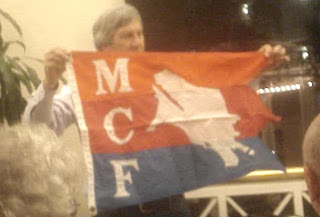 Vexi
Vexi-bit #9: Bill
Trinkle - gave airtime about the wonderful and virtual
Bear Flag Museum. Spoke about native sons of the Golden West - who celebrated the 50 anniversary as a state in 1900. This group made extra effort to promote their flag. Showed us the California Democratic Convention flag of 1984 which fused the Dem Donkey in Cali-style.
Trinkle also showed us a flag of Marin County - a horizontal
tri-bar from the bottom up of blue, red, and orange. It has a double swallow tail, in the center is a white shape of the county, and by the fly are the letter M on orange, C on red, and F on blue near the fly. Ted Kaye suggested that it may not be the flag and rather represent the Marin County Fair.
 Vexi
Vexi-bit #10:
Jim Farrigan III - Made a joke that - "sacred cows make the best hamburgers." He told the story of a printing error for the California State flag with blue bears. We were told about the origin of the California Blue Bear flags. It started out as a mistake, but were all sold as novelties. He knew the Democrats were going to loose the 1984 election because the CA democratic party wanted to rent a presidential flag instead of purchasing one.
 Vexi
Vexi-bit #11:
Roman Klimes - spoke a wee bit about European Flags.
Vexi-bit #12: A bit about NY State flags
Vexi-bit #13: Ted Kaye - Enlightened us a
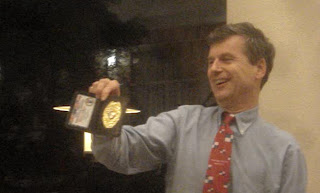
bout the on goings of the
Portland Flag Association. It has about 20-25 members with an average of 12 persons showing up for each meeting. This truly unique "Oregon-ization" has become the leading voice in Portland for effective flag design. Kaye also showed us the first semi-official
vexillological 'Flag Police Padge.' In the center was a coloured version of the official state seal of Oregon.
 Vexi
Vexi-bit #14: Amy Langston - the youngest speaker and
vexillologist at the
ICV 24. She spoke about how she became interested in flags. She became aware of this congress though
Wikipedia, and decided to attend. She like many
vexilloligist recalled an interest in flags tracing back to the flag section in an
Almanc that was foundational to her interest in flags.
 Vexi
Vexi-bit #15:
Jelena Borošak-
Marijanović - We saw a Croatian warship flag. It features the famous Croatian Checker Coat of Arms with two crossed golden anchors in the background.
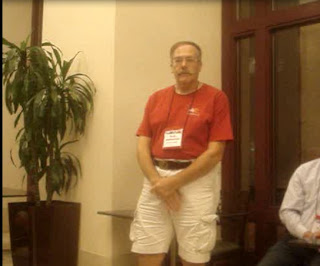 Vexi
Vexi-bit #16:
Nick Artimovich - Exposed his methodology of getting old retired flags from the US State Department - that included old Afghanistan and old Finland flags.
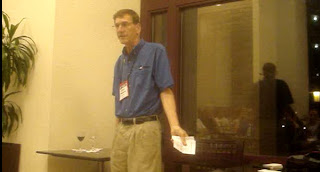 Vexi
Vexi-bit#17: Clyde Simpson - He added a discussion of science/chemistry with
vexillology. Simpson also noted that it being his first
ICV and enjoyed
everyones warmth and friendliness.
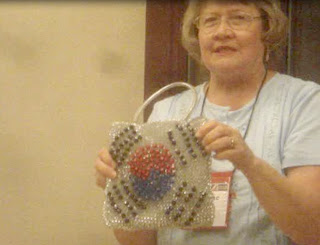 Vexi
Vexi-bit #18: Marlene Little - She showed us a South Korean Flag handbag that she got through her local church when visitors from South Korea came to visit. It is a combination of vexillology and fashion. The red and blue symbol is based upon the ancient Chinese philosophy of Daoism - which heeds a strong call for balance.
 Vexi
Vexi-bit #19: - A new UK Union flag was presented - including the Welsh Cross of St. David and Red Cross for Ulster. Virtual-Imaginary
vexillology got a boost with presentation of imaginary Kingdom of
Aefira. The flags of
Aefira followed in format the official flag of the UK.
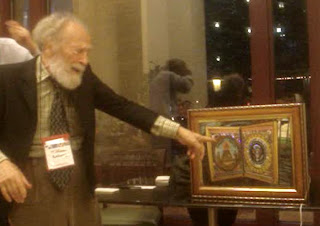 Vexi
Vexi-bit #20: William
Ang - Retro-60s/70s electronic
vexi-art was shown. The US pyramid with flashing lights dazzled our eyes.
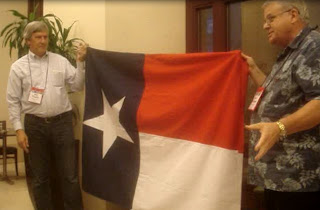 Vexi
Vexi-bit #21: He told us to write on the heading any important places where you may fly a flag. We also saw a mini-model in
proportion of the original Star Spangle Banner from the War of 1812.
 Vexi
Vexi-bit #22: Colin Simpson - He spoke about noticing flags while on a cruse in Alaska.
Vexi-bit #23: John
Hartvigsen - a great talk about flag making with jokes and weird but true stories.
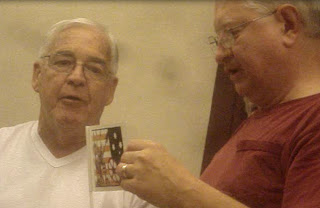
Vexi-bit #24: Ron Strachan from Australia spoke and showed us a colourful and design for the flag of Tiwi Island.
Vexi-bit #24: Christopher
Maddish - I spoke about my flag proposals for the bodies of water on earth and flags for moons and any other heavenly body in our solar system.
--------------------------------------------------------------












































